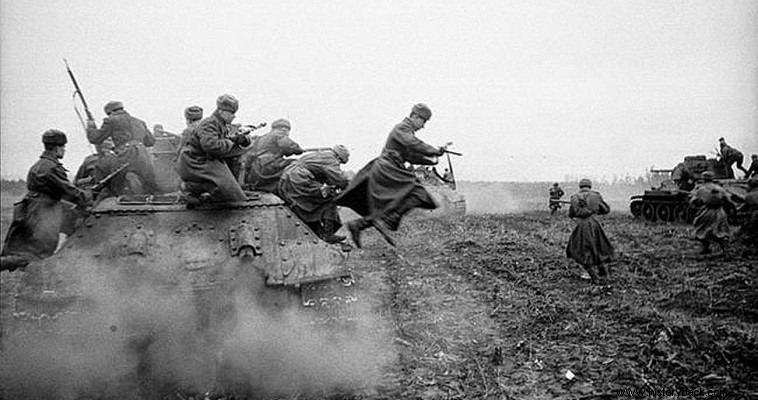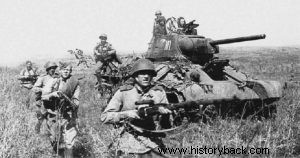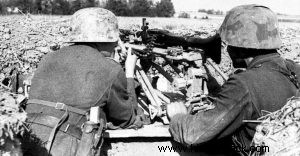
On June 22, 1944, the Soviets launched their biggest counter-attack up to that point with the aim of destroying the German Army Group (OS) "Center". Having succeeded in this, they were now ready to attack the German "Northern Ukraine" OS.
The blow that Hitler had been waiting for months now would finally be delivered, but at the time of the enemy's choosing and with the German reserves, especially the armored ones, scattered to the four winds, literally, in a futile attempt to hold back the Soviet advance into Belarus.
The attack would be launched by the 1st Ukrainian Front (Front =formation equivalent to the Western Army's OSS), under Marshal Koniev, the strongest of the Red Army. On the eve of the attack, Koniev had at his disposal seven tank corps, three motorized corps, six cavalry divisions and 72 Rifle Divisions (MT).
Opposing forces, layout and plans
In total it fielded over 1,000,000 men, 1,614 tanks and assault guns and 14,000 guns and heavy mortars, while being supported from the air by 2,806 aircraft. The attack would also be supported from the north by the left wing of Rokosovsky's 1st Belorussian Front, which had not been seriously involved in the fight until then.
Hitler never wanted to believe that the Red Army possessed such power that it would be able to gather incredibly strong forces in two sections of the Front at the same time.
On the German side, after the transfer of Modell, General Harpe took over the command of the "Northern Ukraine" OSS. It had five tank divisions, one motorized division and 34 Infantry Divisions (IP). In total he fielded 900,000 men, 900 tanks, assault guns and tank hunters and 6,000 guns and heavy mortars, while being supported from the air by some 700 aircraft. At the same time, the Germans had strongly organized the area.
The German organized site extended to a depth of 30 km. Within the site, three lines of defense had been organized and the towns of Vladimir, Volodymyr, Bondi, Zolotchev, Rava Ruskaya and Stanislav had been turned into very well-fortified defense strongholds. Harpe had the 1st and 4th Panzer Armies and the 1st Hungarian Army.
The center of gravity of the defense was the city of Lvov . There the Germans expected the brunt of the Soviet attack to fall and there they had deployed the 3rd Panzer Corps their. The Soviets, in this area, were unable to mislead the Germans about the concentration of their forces. However, they attempted to mislead them about their main area of attack.
Attempts were made to convince the Germans that the major attack would be on the southern part of the front, with Stanislaus as the first objective and not in the direction of Lvov. Soviet efforts were partially successful. The Germans did locate the concentration of the Soviet 1st Guards Armored Army, but not the 3rd Guards Army and the 13th Army, north and south of Lvov, respectively.
The Germans, having learned a hard lesson from the destruction of OS "Kentro", decided, on July 12, to withdraw their infantry from the advanced trenches, so that they would not suffer unnecessary losses from the preparatory bombardment of the Soviets.> After all, they had information that the attack was imminent. Koniev was also informed by his patrols of the movement of the Germans and decided to launch the attack without artillery preparation.
Attack
On July 13 his infantry poured forward. The new great offensive was beginning. However, the Germans, being better prepared and better supported, faced the Soviet raid with greater success. Nevertheless, on July 15 the German front in the Brody area was broken, but not broken up. General Harpe then threw the 1st and 8th Panzer Divisions (MPa) into the battle, trying to overturn the Soviets, taking advantage of the heroic defense of the Lvov garrison, which had managed to stop the Soviets.
STAVKA (Soviet High Command) had ordered Koniev not to bring into battle the 3rd Guards Army and the 4th Army, which formed the second echelon of his command. However, the Soviet marshal did not obey. Once informed that his forces had achieved a small breach in the German front in the area of Kotloff, he ordered first the 3rd Guards Army and then the 4th Guards Army to pass through the breach and disrupt the German defenses in depth .
At the same time, he mobilized the 1st Guards Army in the north, under Lieutenant General Katukov, Soviet Guderian and General Baranov's Motorized Army. Koniev's checkmate move paid off. Despite the heroic resistance of Harpe's two panzer divisions, east of the city, the armored spikes of the 3rd Guards Army reached the outskirts of Lvov.
On July 18, Rokosovsky's left wing, in the north, attacked in turn. The Soviet strikes were now staggered and unanswered, so that the Germans would not be able to react, having engaged their reserves.
Within two days the forces of the 1st Belorussian Front had broken through the German resistance and the Soviet 8th Guards Army and 69th Army were marching towards the Polish city of Lublin. On July 20, there was also an attempt against Hitler by a group of German officers and the confusion became general.
Meanwhile the battle of Lvov continued. The Germans resisted furiously, and Harpe moved forces from the Stanislaus sector, south, to Lvov. Koniev did not wish to pin down his fast moving armies around Lvov and decided to leave the elimination of the enclave to the infantry. But the situation was now borderline for the Germans.
Brody's surrender, in addition to leaving 30,000 German prisoners in Soviet hands, freed up Soviet infantry formations, which could now be deployed in Lvov. By July 24 Katukov's 1st Guards Army in the north and Rybalko's 3rd Guards Army in the south had completely closed the cordon around Lvov and had even reached 70km. further west, on the Shan River and they installed extensive causeways.
Advance to the Vistula
Lvov's garrison, however, managed to escape, most of it at least, on 26 July. The city was finally cleared the next day by the Soviet infantry. On the same day, Soviet forces reached the foothills of the Carpathians, occupying the town of Przemyśl. The Soviet administration, faced with this new success, set new ambitious goals. The crossing of the great river Vistula was now set as a new objective.
Forces of the 2nd Belorussian Front, led by General Zakharov, as well as Rokosovsky's 1st Belorussian Front were advanced there, and managed to cross the river and establish a bridgehead in the area of Magnuchev. On August 1st, Soviet soldiers faced Warsaw. But Koniev's forces also crossed the Vistula in the area of Sandomierz.
Continuing his advance, Koniev forced the Northern Ukrainian Army to retreat from the region of Galicia - southern Poland - cutting it in half and forcing half to seek support in the Carpathians and the other on the west bank of the Vistula, as far as length he could control her. Nevertheless, the German resistance did not collapse.
On August 8, the Germans launched a strong counterattack against the Soviet bridgehead at Magnuchev, but did not succeed in eliminating it. After this the Soviet offensive stopped. This was the last major conflict on the Northern Front until January 1945. Only to the south in the Balkans would operations continue, forcing the Germans to abandon what proved to be temporary conquests.


